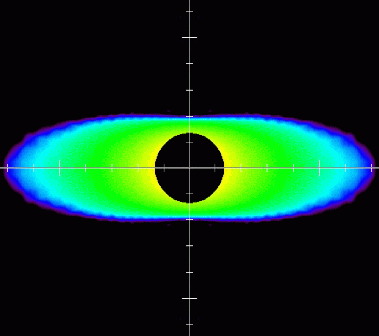| MPA-HOMEPAGE |
|
 |
A Solution for the Nonuniqueness Problem of the Spacetime Constraint Equations | ||
|
|
 Go to:
|
I. Cordero-Carrión ( P. Cerdá-Durán H. Dimmelmeier ( J.L. Jaramillo ( J. Novak ( E. Gourgoulhon (  Introduction:
Introduction:
When trying to numerically calculate the spacetime of very compact stellar objects like hypermassive neutron stars or nascent black holes with the original CFC approximation of Einstein's equations for the spacetime metric [Isenberg, 1978; Wilson, et al., 1996], one observes that in the mathematics underlying a particular part of those equations (the so-called elliptic constraint equations) there exists a fundamental problem with non-uniqueness of the solution. This means that more than one mathematically correct solution is possible, and only one of them is physically correct (although the other one still exhibits the correct value at spatial infinity by obeying asymptotic flatness). Moreover, this problem is aggravated, as in the strong gravity regime, the numerical solver designed to find the physically correct solution always converges to the incorrect one. This issue is not related to the approximative nature of CFC but also occurs in spherical symmetry when CFC is equivalent to full general relativity. Consequently, it also poses a serious problem for a recently proposed, promising reformulation the Einstein equations (the new maximally constrained evolution scheme) which possesses otherwise superior properties for numerics like high accuracy and stability. After spending several years of tracking down this issue, we have recently managed to find a reformulation of the constraint part of the metric equations that has the fundamental property of overcoming the non-uniqueness problem [Cordero-Carrión, et al., 2008]. We have recently realized that this reformulation has already been used some time ago by Saijo in simulations of supermassive stars collapsing to black holes [Saijo, 2004], although at that time the importance of this method for guaranteeing mathematical uniqueness has not been realized. In addition, similar solutions to this problem had been found for initial data (in the extended conformal thin sandwich decomposition) or spherical symmetry before. However, we are now able to show that the reformulation also works for fully dynamic spacetimes without symmetries, and can thus be generally applied to simulations of very compact astrophysical object without any symmetry restrictions. Our results clearly demonstrate the important and nontrivial effects of the choice of the mathematical formulation on the behavior of a numerical code. 
Using the new reformulation of the CFC approximation of the metric equations, we have been able to successfully simulate various demanding astrophysical scenarios involving very compact objects, like the migration of an unstable neutron star to a stable configuration, or the gravitational collapse of a hypermassive neutron star to a rotating black hole beyond the formation of the apparent horizon. Numerical studies of such systems with the numerically otherwise advantageous CFC method were previously either impossible, or were hampered by the introduction of mathematical inconsistencies at the expense of accuracy of the solution. With this extension, the CFC approximation which has been very successfully used in a large number of studies of astrophysical phenomena before (like rotating stellar core collapse in supernovae with or without magnetic fields, or pulsations in rotating neutron stars; see e.g. [Dimmelmeier, et al., 2002; Dimmelmeier, et al., 2006; Cerdá-Durán, et al., 2007; Dimmelmeier, et al., 2008]) can now also be utilized for more extreme scenarios like numerically simulating the formation of black holes.
|